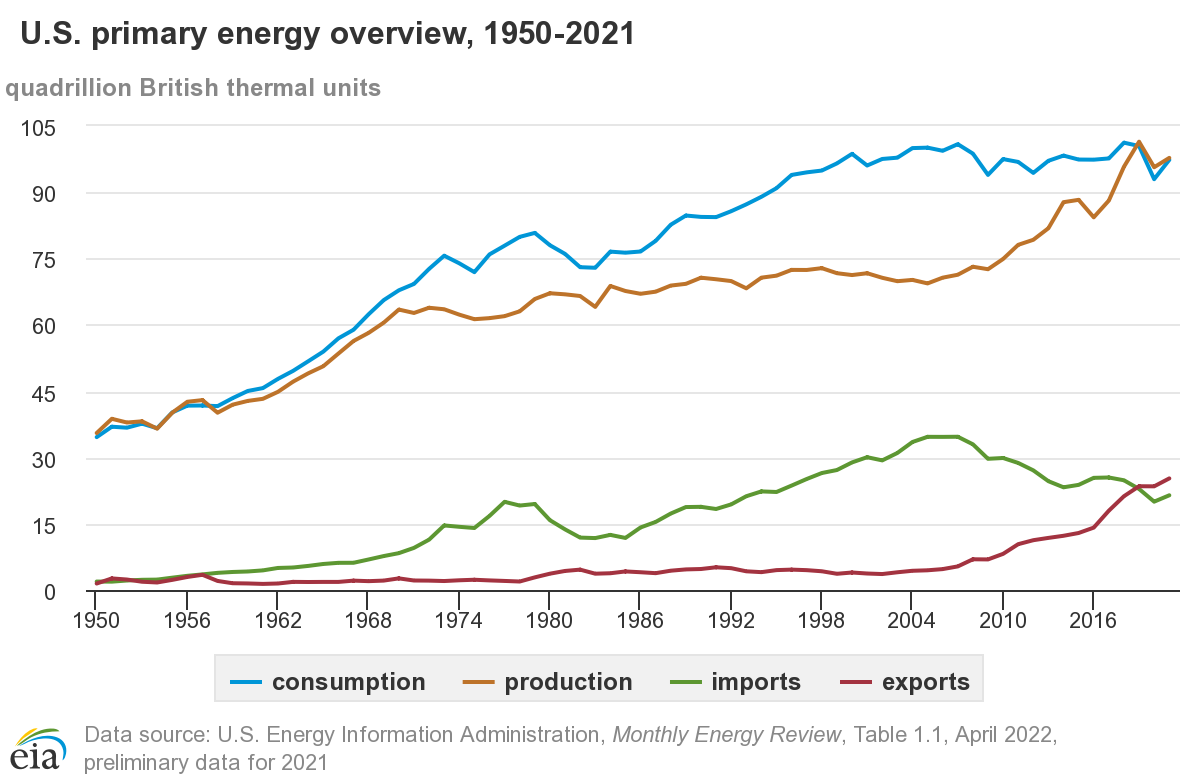I am often asked if the U.S. is energy independent, or whether we have ever been energy independent. I frequently encounter a claim that President Trump made us energy independent, and we lost that under President Biden.
Before addressing such a claim, you must ensure that everyone is speaking the same language. When someone makes that claim to me, I ask them to define energy independence.
If energy independence means we don’t import oil, then that hasn’t been true since the 1940s. If it means we export more energy than we import, then we became energy independent in 2019 (following a decade of soaring oil and gas production), but we remain energy independent today.
Others may define energy independence as producing more than we consume. In that case, we reached that milestone in 2020. It was primarily a result of a sharp drop in consumption because of the Covid-19 pandemic, accompanied by a smaller drop in energy production that year. But, that milestone remained intact in 2021.
It is true that we achieved both of those energy independence milestones under President Trump. What isn’t true, is that it was because of anything special that he did. His energy policies may have helped a bit, but the primary cause was a surge in domestic oil and gas production that occurred as a result of the fracking boom.
From 2006 to 2016, U.S. energy production increased from 70.7 quadrillion British thermal units (quads) to 84.3 quads. The U.S. experienced record energy production in 2015, but 2016 production pulled back because of the oil price collapse.
During Trump’s term — 2017 through 2020 — U.S. energy production increased by another 11.3 quads (although, again, 2019 was a record year and 2020 production declined because of the pandemic). The rate of increase was a bit higher under President Trump, which you can see in the graphic below. But the trend of surging energy production and falling energy imports since 2006 is also clear.

U.S. Primary Energy Overview
So President Trump didn’t make us energy independent. In fact, the gap between supply and demand substantially shrunk when President Obama was in office (again, because that’s when fracking really ramped up). But it would be fair to argue that President Trump’s energy policies slightly sped up the timeline in getting to the finish line of energy independence.
However, what isn’t true is that we lost that energy independence under President Biden.
Related: The LME Is Carefully Considering A Potential Ban On Russian Metals
Using the definition of exports minute imports, 2021 was our highest level of energy independence in history. In other words, we are even more energy independent than we were in 2019. (You can see all the data in U.S. Energy Facts Explained at the EIA website, which is also the source of the above graphic).
You can see the proof at the link. In 2019, our energy exports were greater than our imports by 0.61 quadrillion Btus (quads). In 2020, that excess grew to 3.47 quads (mainly because imports fell as Covid hit demand) and in 2021 it grew to a new record of 3.82 quads. By that measure, we are more energy independent than we have ever been.
If you prefer the definition of production minus consumption, then we are also still energy independent. In 2020 the U.S. produced 2.7 more quads than we consumed. In 2021, that excess shrank to 0.45 quads on the back of strong post-shutdown demand. So you could argue that by that measure our level of energy independence declined from 2020 to 2021, but it didn’t disappear.
If your preferred definition of energy independence is that we don’t import energy, as you can see from the graphic we haven’t come close to meeting that metric at any point since the 1950s.
So, on an apples-to-apples comparison, depending on your definition we are either still energy independent, or we never were.
By Robert Rapier
More Top Reads From Oilprice.com:
- Germany Needs To Slash Natural Gas Consumption To Avoid A Winter Emergency
- European Leaders Gather To Discuss Energy And Security
- Putin Sees Pakistan As A Potential Partner In Southeast Asia


















